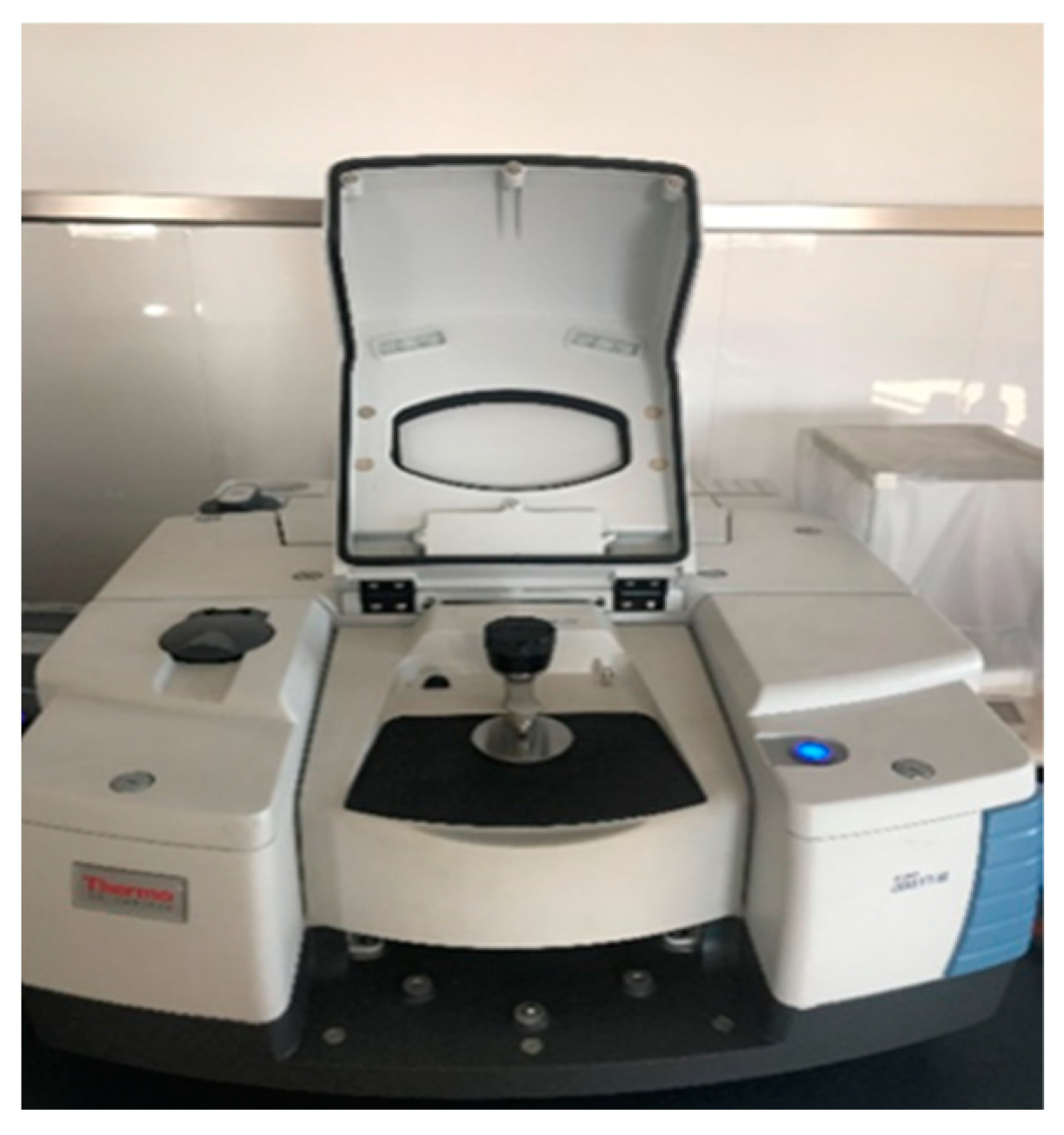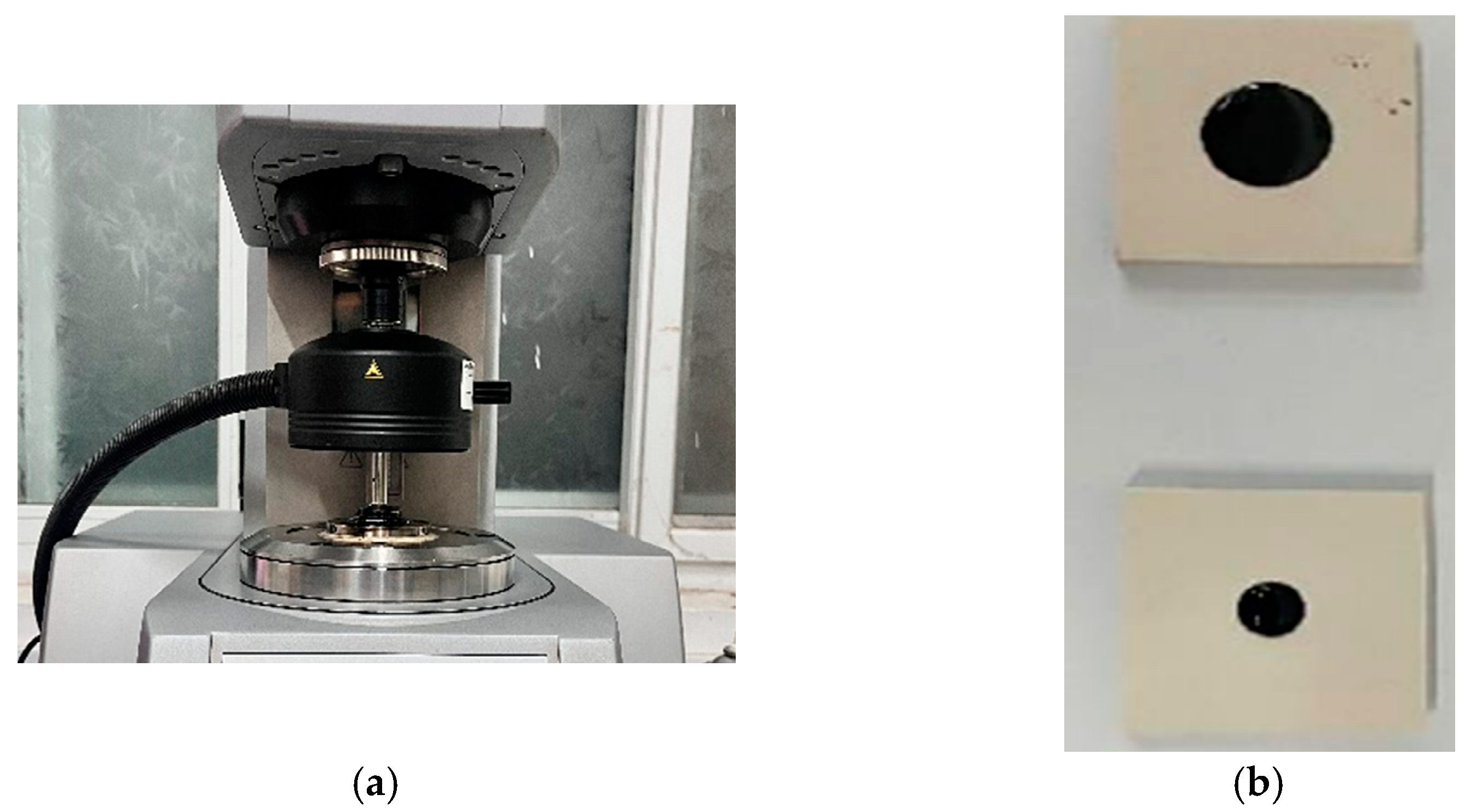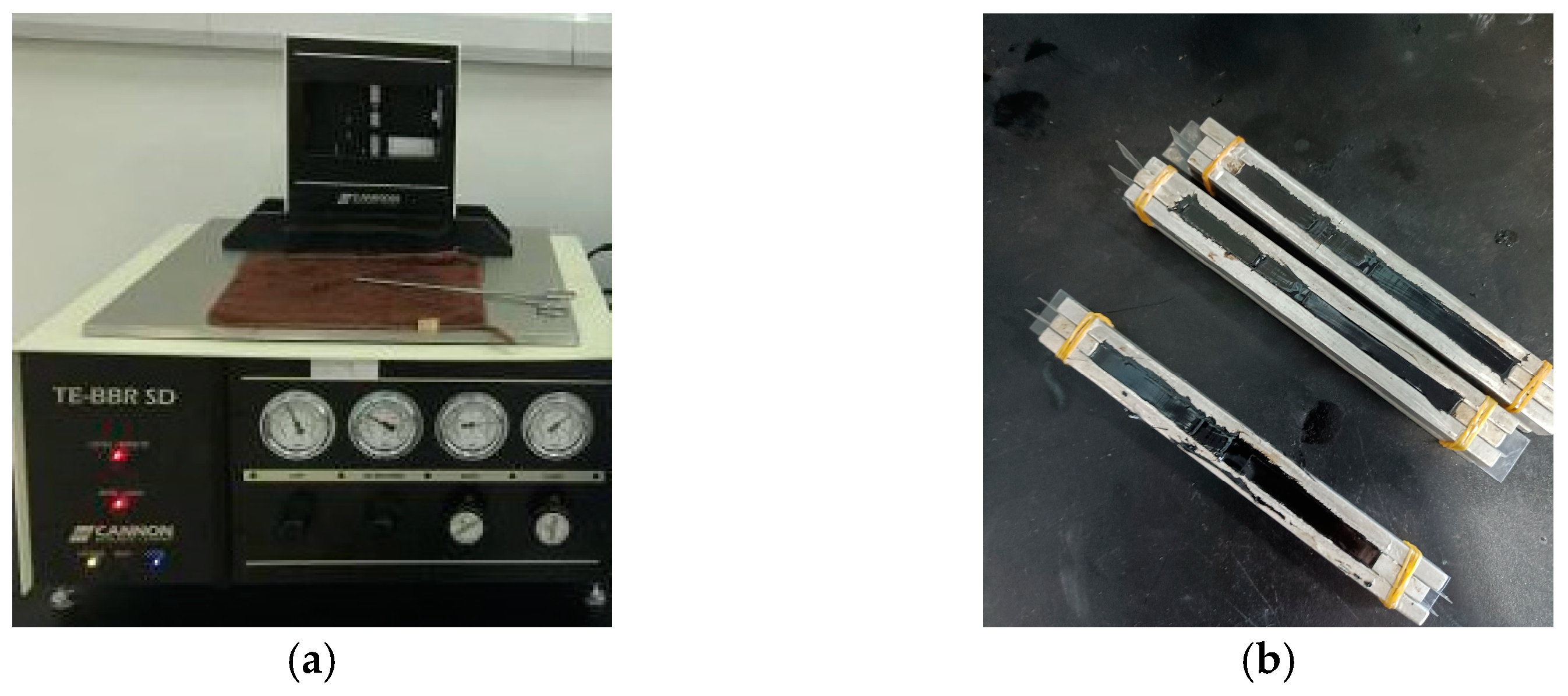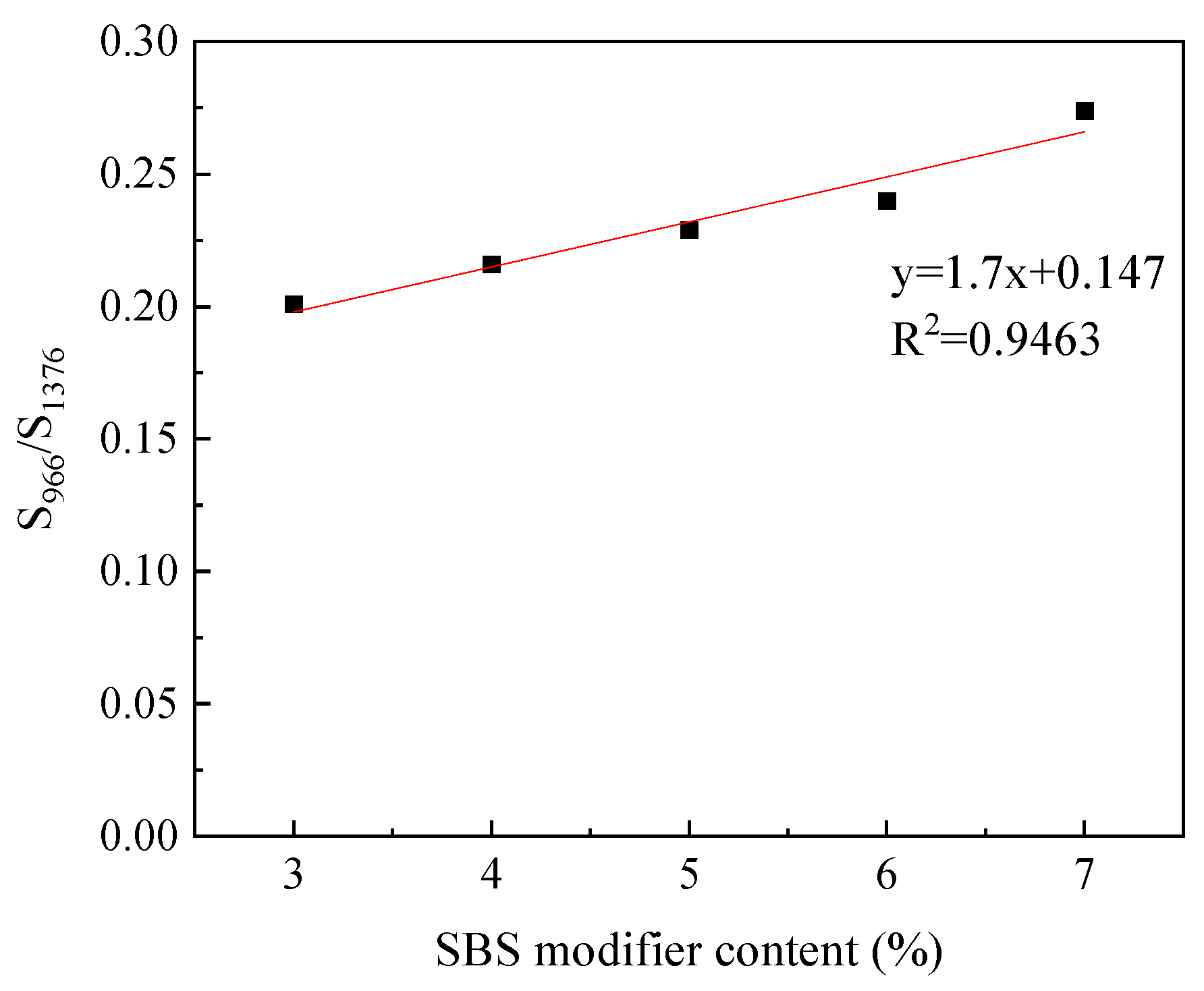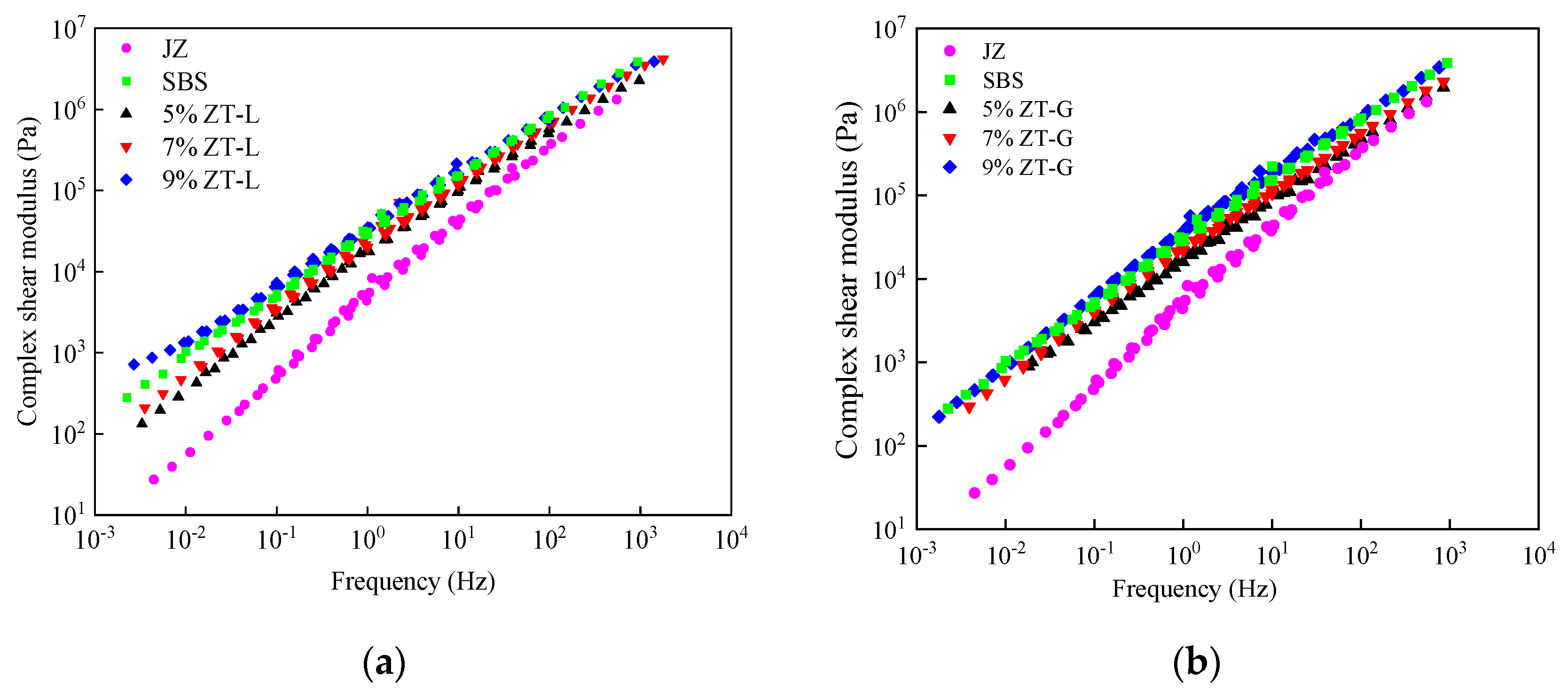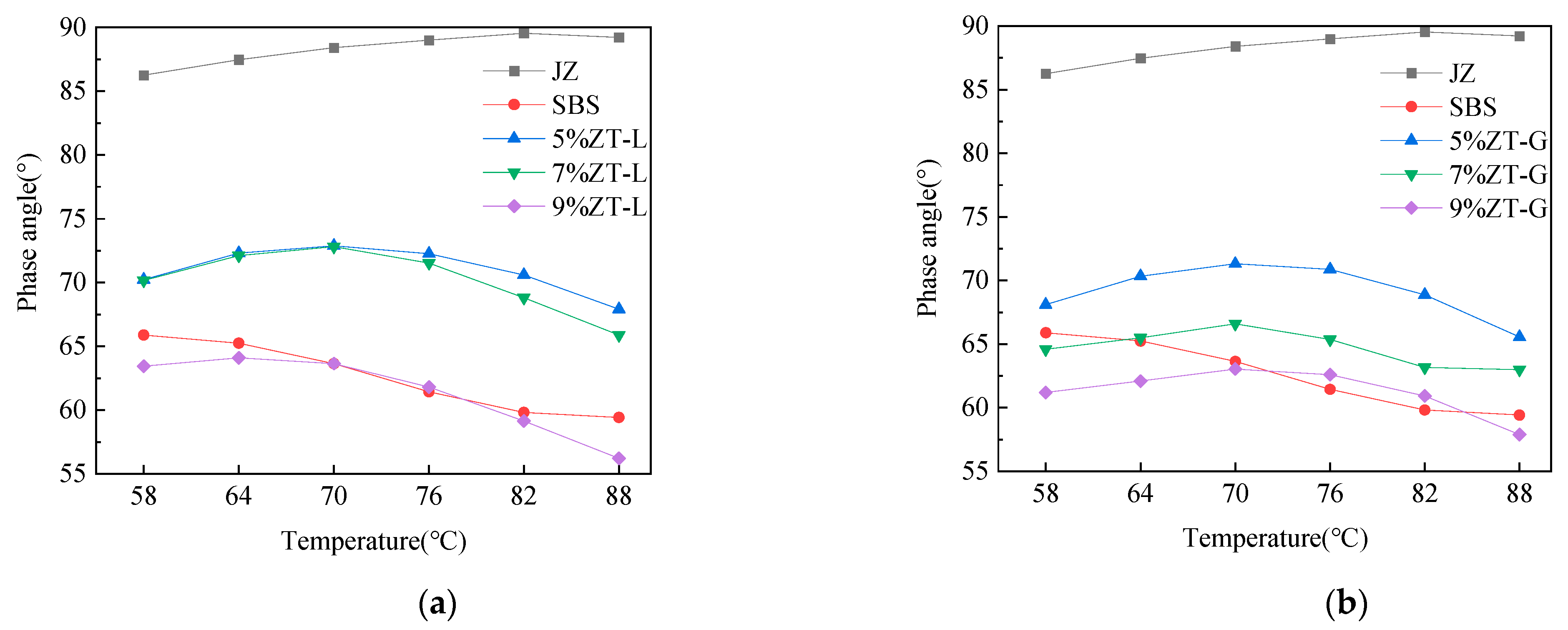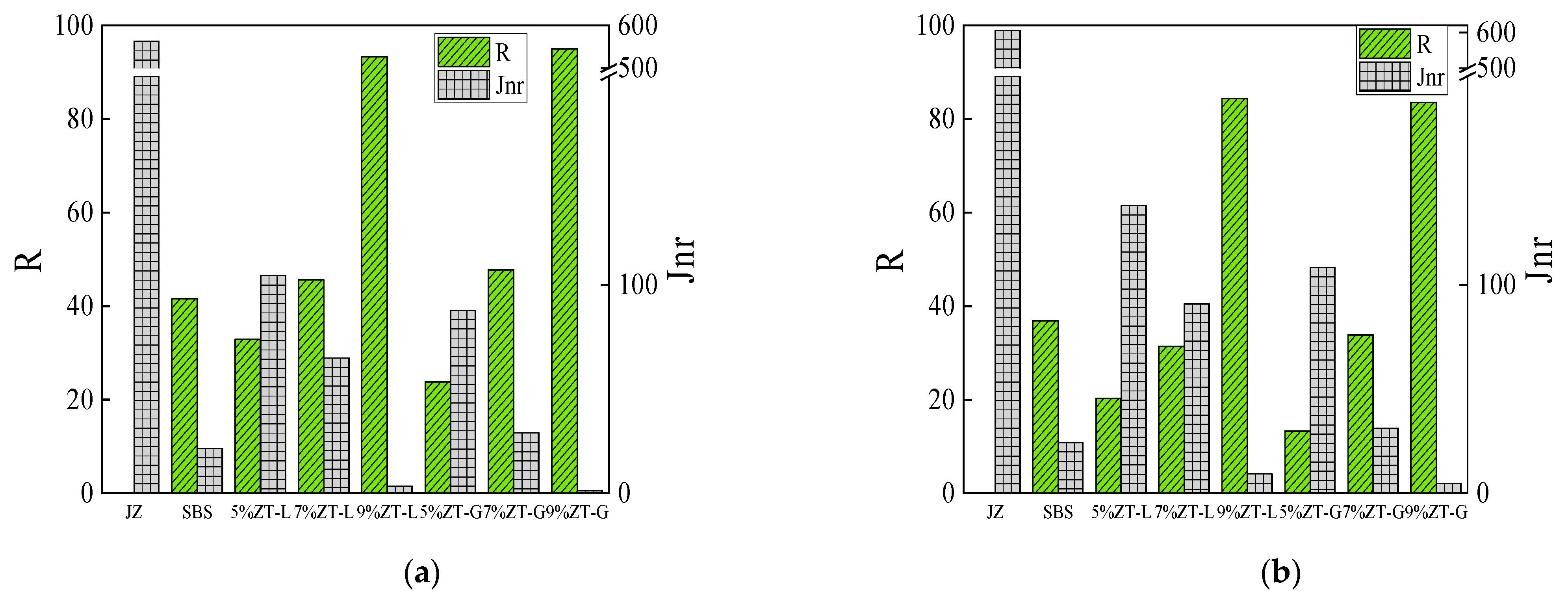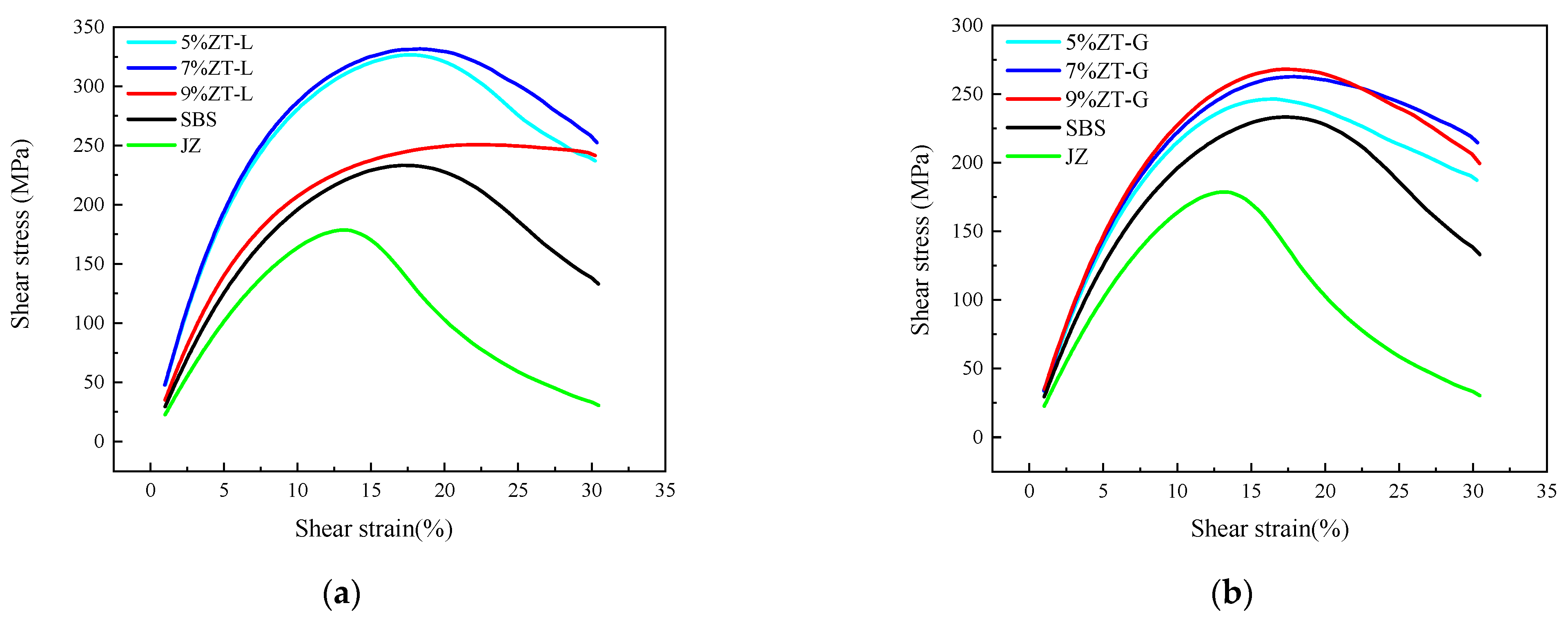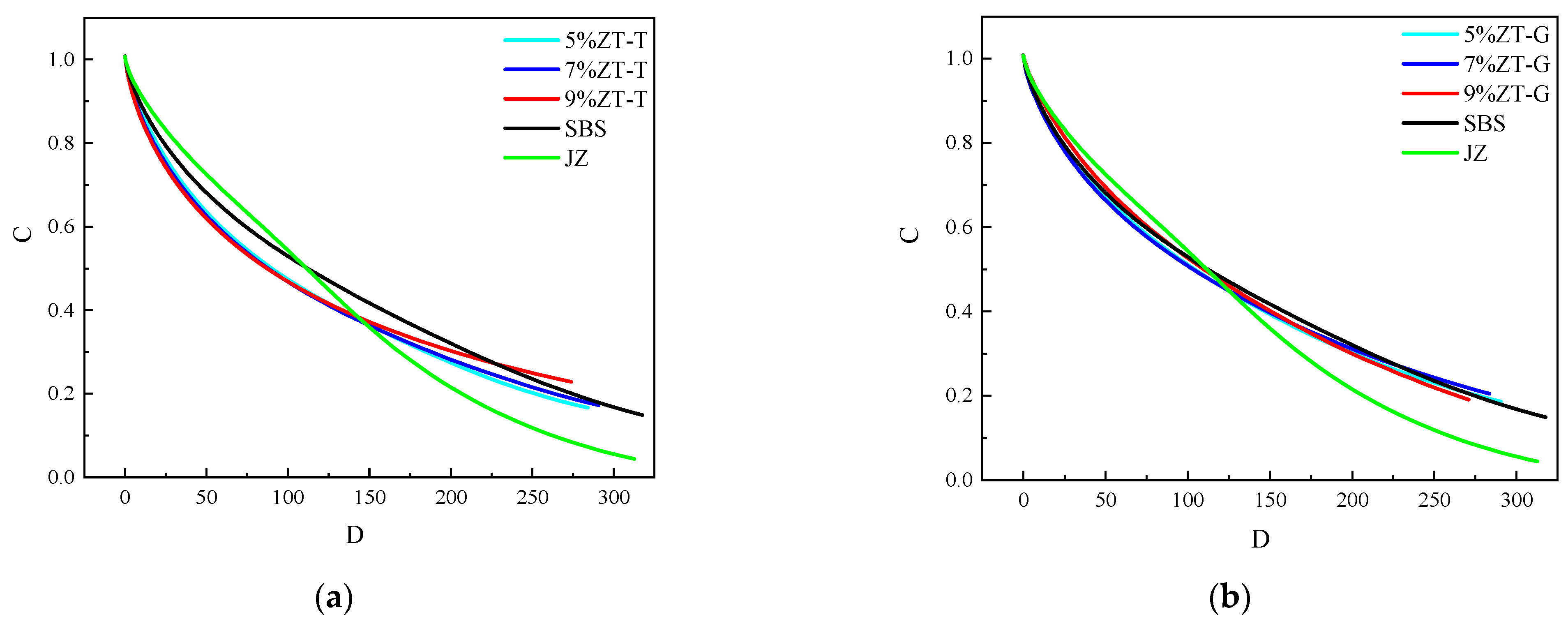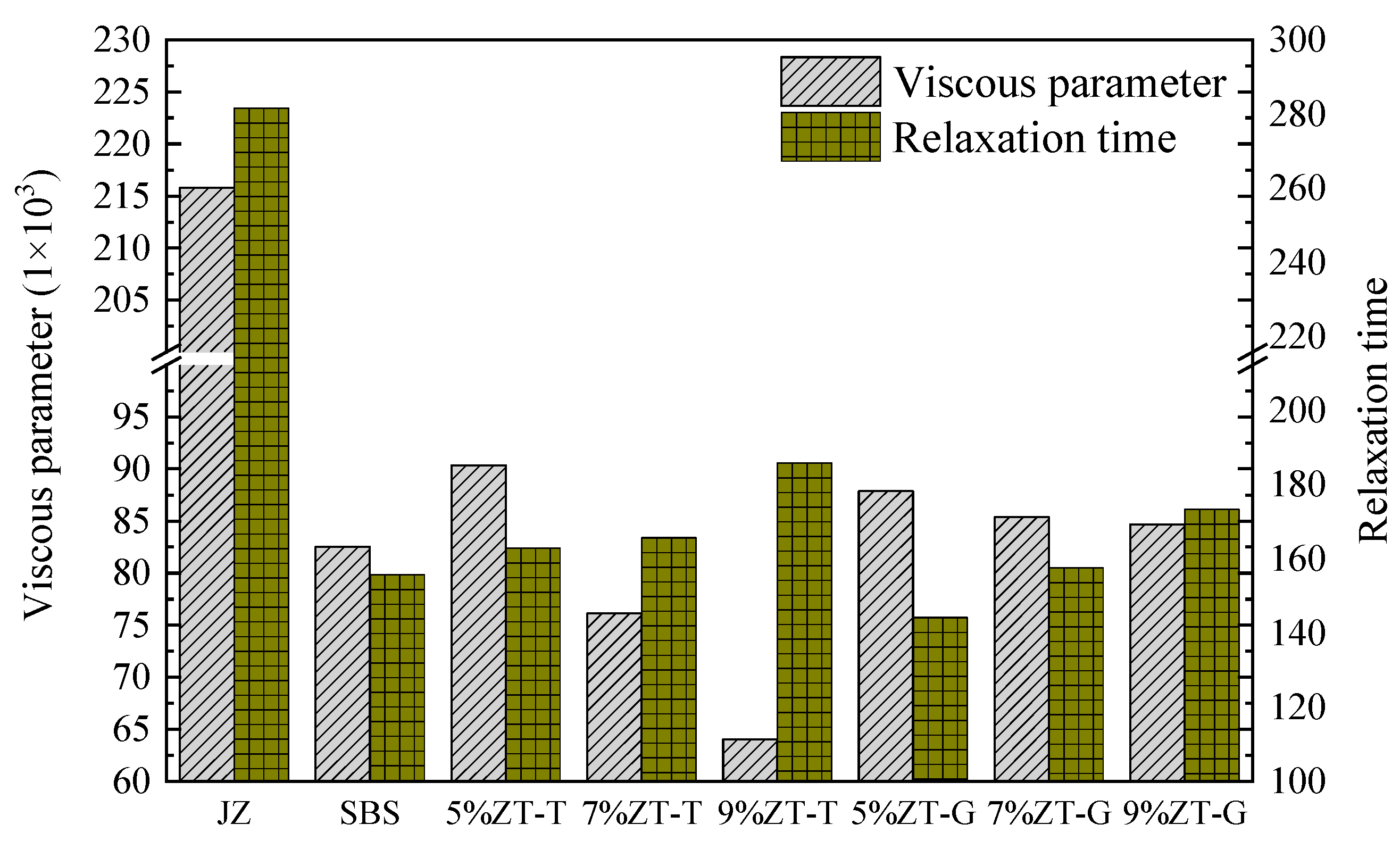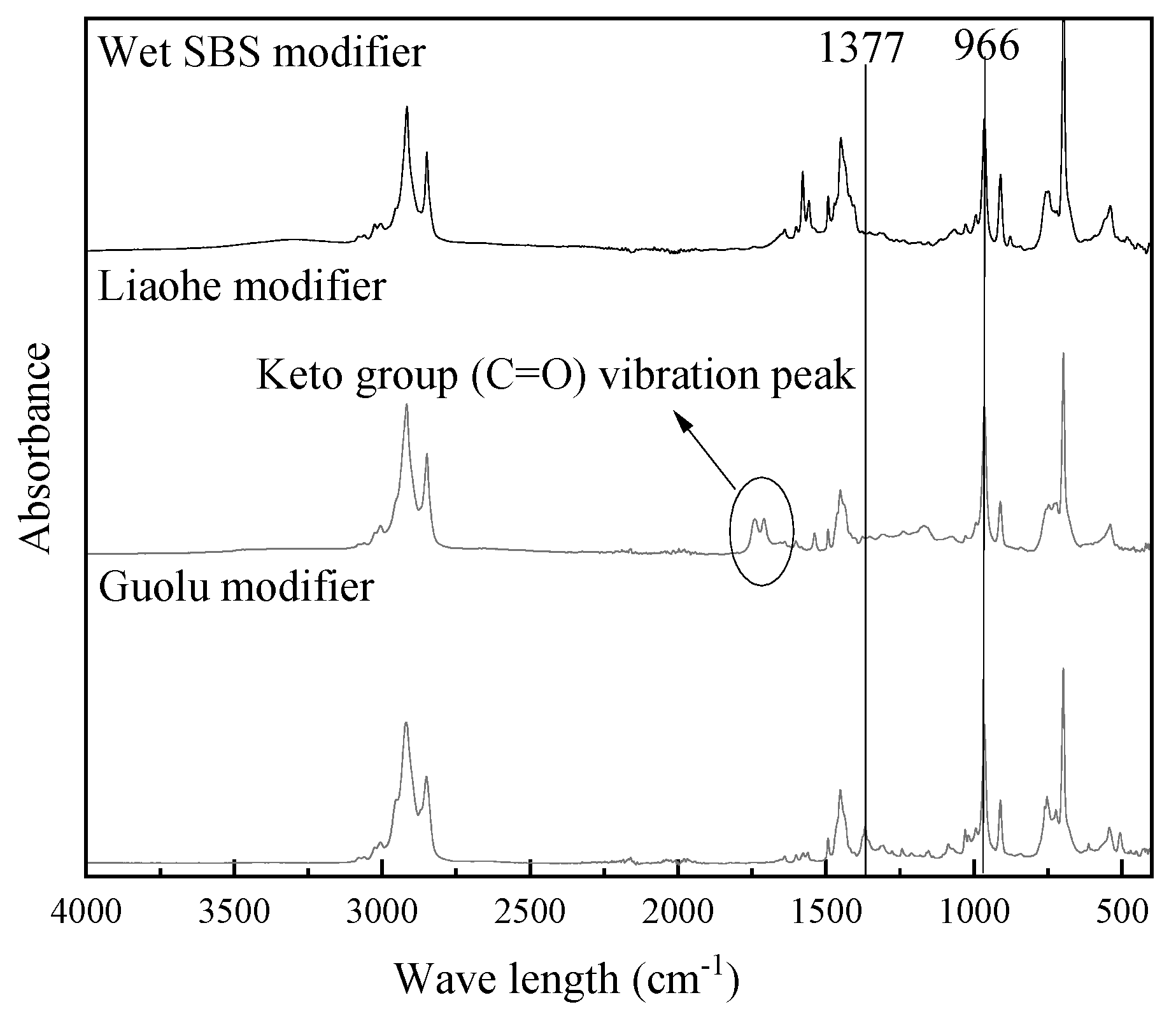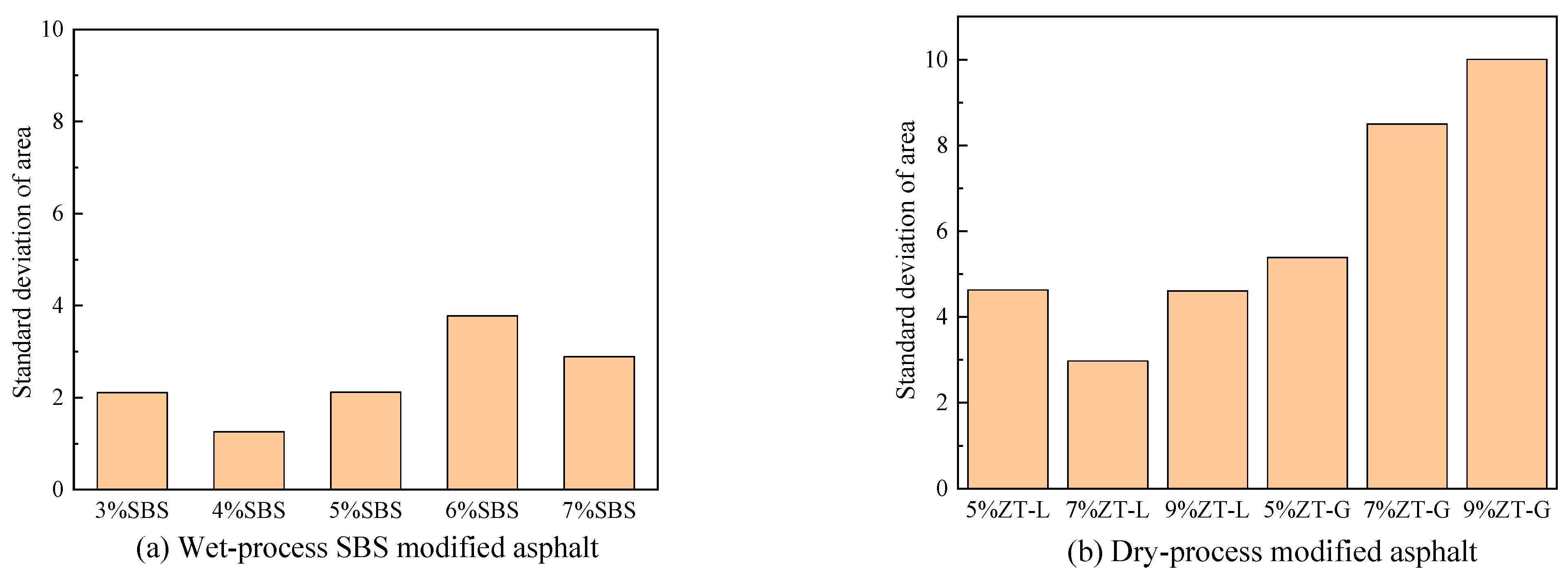3.1. Preparation Process of Dry-Process SBS-Modified Asphalt Binder
To study whether a dry-process SBS modifier can fully play the role of modification, and to study the performance index of a modified asphalt binder in a dry-process SBS-modified asphalt mixture to the greatest extent, it is necessary to obtain modified asphalt binder from a dry-process SBS-modified asphalt mixture by unconventional means. In the process of preparing a dry-process SBS-modified asphalt mixture, the modifier is melted and dispersed in virgin asphalt binder during mixing, and the aggregate plays the role of shearing and grinding. Because dry-process SBS modifier has the characteristic of easy melting if the modified asphalt binder is prepared by the traditional wet process, the melting effect and dispersion state of the dry-process SBS modifier cannot be reflected, so its action characteristics should be considered when preparing the modified asphalt binder, and the modifier should directly interact with the asphalt binder under the grinding action of the stone to obtain dry-process SBS-modified asphalt binder. Referring to relevant research [
25] and the continuous adjustment of temperature and time used in actual tests, the preparation processes of two dry SBS-modified asphalt binders were preliminarily determined. The gradation and nature of the coarse aggregate used are shown in
Table 5. The preparation and extraction process of dry SBS-modified asphalt binder is shown in
Figure 2 and
Figure 3.
Plan 1: Preheat coarse aggregate with a particle size greater than 9.5 mm to 185 °C, pour it into a mixing pot at 180 °C, add dry-process SBS modifier to stir for 30 s, and then pour virgin asphalt binder into the mixing pot for 90 s. The mixed mixture is placed in an iron net and placed in an oven at 180 °C for 2 h to collect the asphalt binder dripping from the iron net. The detailed procedure is shown in
Figure 5.
Plan 2: To obtain a dry-process SBS-modified asphalt binder that is closer to the real dosage, it is necessary to make full contact between the asphalt binder and the modifier. The preparation process of this plan is as follows: coarse aggregate with a particle size greater than 9.5 mm is preheated to 165 °C and poured into a mixing pot at 160 °C, and virgin asphalt binder and dry-process SBS modifier are poured into the mixing pot at the same time for stirring. To ensure uniform mixing, the mixing time is set to 120 s, and then the dry-process SBS-modified asphalt mixture after mixing is contained in an iron mesh and placed in an oven at 180 °C for 2 h; the asphalt binder dripping from the iron mesh is collected. The preparation process not only reduces the extrusion and friction effect of stone on the modifier during the preparation of the mixture but also enables the asphalt binder to be evenly mixed with the modifier, in order to obtain dry-process SBS-modified asphalt binder with close to the real content. The detailed procedure is shown in
Figure 6.
Through comparison, it is found that the dry-process SBS-modified asphalt binder prepared by plan 2 is more uniform, and a dry-process SBS-modified asphalt binder can be obtained with close to the real content. Referring to the “Test Regulations for Highway Engineering Asphalt and Asphalt Mixture” (JTG E20-2011), the basic indexes of the 5% dry-process SBS-modified asphalt binder prepared by the two plans were compared, and the results are shown in
Table 6. In this paper, the modified asphalt binders prepared by Liaohe and Guolu brand dry modifiers are named ZT-L and ZT-G, respectively.
Table 6 shows that the basic indicators of plan 2 are significantly better than those of plan 1. Due to the large amount of oil and stone used in the preparation process and the large amount of modifier, a small amount of modifier clumping will occur during the mixing of modifier and stone in plan 1, resulting in insufficient modifier content in the prepared modified asphalt binder. In plan 2, because the asphalt binder is added before the modifier, the modifier will be melted and dispersed in the asphalt binder under the simultaneous action of asphalt binder and stone during the mixing process. Asphalt binder plays a role in inhibiting the formation of modifier agglomeration, and the modifier can fully contact with the asphalt so that the modifier content of the modified asphalt binder prepared by plan 2 is closer to the real dosage.
Therefore, in this study, plan 2 was used to prepare dry-process SBS-modified asphalt binder, and then performance and microscopic tests of the asphalt binder were carried out.
3.2. Rheological Properties of Dry-Process SBS-Modified Asphalt with Different Dosages
According to the Determination of Rheological Properties of Asphalt (DSR Method), a DSR was used to measure the complex shear modulus G* and phase angle δ of the modified asphalt at a given temperature and load frequency. In this way, the viscoelastic properties of the modified asphalt were characterized. Firstly, the linear viscoelastic interval of each modified asphalt sample was determined by stress–strain scanning, and a frequency sweep, temperature sweep, multiple-stress creep recovery test, and linear amplitude sweep test were carried out on each modified asphalt sample in the linear viscoelastic interval. Two sets of parallel samples were tested in all experiments.
3.2.1. Frequency Sweep Test
In order to characterize the viscoelastic properties of asphalt pavement under a dynamic load during service, a sweep test with a DSR was carried out to obtain the complex shear modulus G* and phase angle δ by continuously changing the loading frequency of the asphalt specimens. The complex shear modulus G* is the ratio of the maximum shear stress and shear strain of linear viscoelastic materials under a continuous sinusoidal load and is an evaluation index of total resistance. It consists of two parts: real and imaginary components, as shown in formula 1. Of these, G′ is the dynamic modulus of elasticity, that is, the elastic part, which reflects the energy stored during the deformation of asphalt. G″ is the loss modulus of elasticity, that is, the viscous part, which is equivalent to the loss modulus of elasticity produced by dynamic viscosity, reflecting the energy lost in the form of heat due to internal friction in the process of deformation of asphalt. Therefore, the measured complex shear modulus was constructed as a time–temperature-equivalent master curve with 48 °C as the reference temperature. The master curve of the modulus at any other temperature and frequency can be obtained by translating the displacement factor, and the results are shown in
Figure 7.
where G*—complex shear modulus, G′—dynamic elastic modulus, and G″—loss of elastic modulus.
It can be seen from
Figure 7a,b that compared with virgin asphalt, the complex modulus of several modified asphalts has been significantly improved, and with an increase in the dosage, the complex moduli of two dry-process modified asphalts increase.
As can be seen from
Figure 7a, the magnitude of the complex modulus is 9% ZT-L > SBS > 7% ZT-L > 5% ZT-L > JZ at low frequency. In the principle of time–temperature equivalence, low frequency represents high temperature, and the larger the complex modulus at a low frequency, the stronger the shear deformation resistance at a high temperature. At a high frequency, the performance of 9% ZT-L-modified asphalt is comparable to that of wet SBS-modified asphalt, and the complex modulus of the rest of the asphalt samples is the same as that at a low frequency. Overall, the shear deformation resistance of 9% ZT-L for asphalt was the most improved, and the wet SBS-modified asphalt was between 9% ZT-L-modified asphalt and 7% ZT-L-modified asphalt.
Through
Figure 7b, it can be found that the magnitude relationship of the complex modulus is 9% ZT-G > SBS > 7% ZT-G > 5% ZT-G > JZ, and the complex modulus of 9% ZT-G- and SBS-modified asphalt is comparable to that in the high-frequency and low-frequency stages.
3.2.2. Temperature Scan Test
To study the relationship between the viscoelastic properties of each asphalt and asphalt type, temperature, and modifier content, the viscoelastic state of each asphalt sample at different temperatures was analyzed through the phase angle obtained by temperature scanning. In this study, a temperature range of 58–88 °C was selected for scanning; the temperature interval was 6 °C, and the scanning frequency was 1.59 Hz. The phase angle and rutting factor of ZT-L-modified asphalt, ZT-G-modified asphalt, virgin asphalt, and wet SBS-modified asphalt were compared, respectively, and the results are shown in
Figure 8.
By observing the phase angle of each asphalt sample, it can be found that the phase angle of virgin asphalt is the largest, and its phase angle gradually increases with an increase in temperature; the higher the temperature, the smaller the increase in the phase angle. When the temperature reaches 82 °C, the phase angle is close to 90 °C, indicating that the virgin asphalt is close to a viscous flow state at this temperature and almost loses the characteristics of elastomers. However, the performance of modified asphalt is very different from that of virgin asphalt, and it has a certain relationship with the content of modifier. The phase angle of SBS-modified asphalt decreases with an increase in temperature, while the phase angle of ZT-L and ZT-G under each content shows a trend of increasing first and then decreasing with an increase in temperature.
Analyzing the reasons for the above phenomenon, a decrease in the phase angle of SBS-modified asphalt in the temperature-increase stage may be due to the contraction and curling of the SBS molecular chain under the condition of low temperature [
26]; with an increase in temperature, the molecular chain gradually stretches, and the stretched SBS forms a three-dimensional network structure with the virgin asphalt, which offsets the effect of the increase in the viscous component of the virgin asphalt and makes the elasticity of the SBS-modified asphalt gradually increase. The reason why the phase angle of the two dry-process SBS-modified asphalts first increased and then decreased was that when the temperature was not high, the viscoelastic properties of the virgin asphalt dominated with the increase in temperature, and the increase in viscous components led to a gradual increase in the phase angle. However, when the temperature is high, the increase in the viscous component of the virgin asphalt will gradually decrease, and SBS will exert its high elasticity to gradually reduce the phase angle.
To compare and analyze the high-temperature stability and rutting resistance of dry-process SBS-modified asphalt, the rutting factors of several asphalt samples were studied. The rutting factors of several asphalt specimens are shown in
Figure 9.
Compared with the rutting factor of SBS-modified asphalt, the rutting factor of ZT-L and ZT-G with 5% content was smaller. The rutting factor of the two dry-process SBS-modified asphalt was significantly larger than that of the wet SBS-modified asphalt at a 9% dosage, and the rutting factor of 9% ZT-L was the largest. For the two kinds of dry-process SBS-modified asphalt, the rutting resistance was the weakest when the content was 5%; the rutting resistance was comparable to that of the wet SBS-modified asphalt at a content of 7%; and the rutting factor was greater than that of the wet SBS-modified asphalt when the content was 9%, indicating that ZT-L and ZT-G with 9% content had the strongest rutting resistance.
3.2.3. Multiple-Stress Creep Recovery Test
Multiple-stress creep recovery (MSCR) tests were used to analyze the high-temperature performance of dry-process SBS-modified asphalt. The stress levels of the test were 0.1 kPa and 3.2 kPa, and each stress condition consisted of 10 loading cycles, each loading cycle with constant stress for 1 s and unloading recovery for 9 s. According to the characteristics of asphalt, 60 °C was selected as the test temperature in the study, and the creep recovery test results of virgin asphalt and wet SBS-modified asphalt were compared with dry-process SBS-modified asphalt with different dosages; the test results are shown in
Figure 10.
Creep recovery rate (R) is used to characterize the ratio between the rebound deformation and the total deformation of asphalt materials at different stress levels to obtain the elastic properties of asphalt, and the larger the creep recovery rate, the better the high-temperature performance of asphalt. The non-recoverable creep compliance (Jnr) is used to represent the viscous residual deformation of asphalt materials, and the higher its value, the worse the high-temperature resistance of the material.
As can be seen from
Figure 10, due to the poor high-temperature resistance of the virgin asphalt itself, the virgin asphalt has internal damage under a stress of 3.2 kPa, and the creep recovery rate of the virgin asphalt at 0.1 kPa is only 0.1%. Compared with virgin asphalt, the creep recovery rate of wet- and dry-process SBS-modified asphalt was significantly higher than that of virgin asphalt, and the non-recoverable creep flexibility was significantly reduced, indicating that the addition of SBS enhanced the rutting resistance of asphalt. In addition, compared with the non-recoverable creep compliance at 0.1 kPa and 3.2 kPa, the non-recoverable creep compliance at 3.2 kPa is larger, indicating that the asphalt pavement is more prone to rutting under heavy traffic loads. For ZT-L and ZT-G dry-process modified asphalt, with an increase in modifier content, the creep recovery rate of both of them increased significantly, and the non-recoverable creep compliance decreased significantly, indicating that the increase in modifier content enhanced the elasticity of the asphalt. Compared with wet SBS-modified asphalt, ZT-L and ZT-G with a content of 9% have a larger elastic recovery rate and a smaller non-recoverable creep flexibility.
The MSCR results showed that the high-temperature performance of the two dry-process SBS-modified asphalts was significantly higher than that of the virgin asphalt, and the high-temperature performance improvement effect was more significant with the increase in modifier content. Compared with the wet SBS-modified asphalt, the creep recovery rate of the 7% dry-process SBS-modified asphalt is similar, but the non-recoverable creep flexibility is larger, and the stress sensitivity of the dry-process modified asphalt is poor, so the wet SBS-modified asphalt has better high-temperature performance. A comprehensive comparison of the high-temperature performance of ZT-L, ZT-G, and wet SBS-modified asphalt showed that ZT-L and ZT-G with 9% content had the best high-temperature performance; this was followed by wet SBS-modified asphalt, ZT-L, and ZT-G with 7% content, which was slightly worse than that of wet SBS-modified asphalt, and ZT-L and ZT-G with 5% content had the worst high-temperature performance.
3.2.4. Linear Amplitude Sweep Test
A linear amplitude scanning test (LAS) was used to carry out a medium-temperature fatigue test on different bitumen samples. The LAS experiment is mainly divided into two stages. First of all, a frequency scanning test is carried out on the sample in the range of 0.1–30 Hz at a 0.1% strain level. Then an oscillating shear mode under a strain control mode is used at the selected temperature conditions with a loading frequency of 10 Hz, and the strain increases linearly from 0.1 to 30% during 3100 loads, recording the peak shear strain and peak shear stress. Then, the damage characteristic curve of the asphalt sample was obtained by the viscoelastic continuum damage model (VECD model). The vertical coordinate C represents the integrity parameter of asphalt, and the horizontal coordinate D represents the cumulative damage parameter. When C = 1, the asphalt sample is in an undamaged state. When C = 0, the asphalt sample has been completely destroyed. When the cumulative damage parameter D is given, the greater the C, the stronger the material’s resistance to fatigue damage.
Stress–strain curves of virgin asphalt, SBS-modified asphalt, and dry-process SBS-modified asphalt are plotted as shown in
Figure 11, and a fatigue damage curve is shown in
Figure 12.
The stress–strain curves of each asphalt sample are compared and analyzed in
Figure 8. As can be seen from
Figure 11a, the strain level of several modified asphalts at the time of initial failure is significantly greater than that of virgin asphalt, indicating that the addition of three modifiers reduces the dependence of asphalt on strain, and the width of the peak zone of 9%ZT-L is the largest, which proves that its strain sensitivity is the least. At the 5% dosage, there was no significant difference between the strain and peak area width of the two dry-process modified asphalt and the wet SBS-modified asphalt at the initial failure. As can be seen from
Figure 11b, 5% ZT-G has the lowest dependence on strain, while 7% ZT-G and 9% ZT-G have no significant difference in strain during fatigue failure, and there is no significant difference in the width of the peak region. The shear stress of the two types of dry-process-modified asphalt is greater than that of the wet SBS-modified asphalt during fatigue failure.
The fatigue damage curve of asphalt was analyzed. The slope of the fatigue damage curve is representative of the speed of damage. As can be seen from
Figure 12, virgin asphalt has the largest slope and the largest damage velocity. Compared with wet SBS-modified asphalt, ZT-L has a faster damage rate in the early stage, but the damage rate slows down in the later stage, showing a different law from that of wet SBS-modified asphalt. The damage curve trend of ZT-G and wet SBS-modified asphalt is the same. The fatigue life calculation and estimation results of the LAS test are shown in
Table 7.
Through
Table 7, we find that the fatigue life of the three modifiers for virgin asphalt is greatly improved, and the different types of dry-process modifiers exhibit different rules. The 2.5% strain level characterizes a low-strength pavement, while the 5% strain characterizes a higher-strength pavement. For the fatigue life of each asphalt sample at a 5% strain level, the fatigue life of all modified asphalt samples is greater than that of virgin asphalt, and all of them are more than twice that of virgin asphalt. The fatigue life of ZT-L and ZT-G at a 5% dosage is slightly smaller than that of wet SBS-modified asphalt, the fatigue life of ZT-L and ZT-G at 7% dosage is comparable to that of wet SBS-modified asphalt, and the fatigue life of ZT-L and ZT-G at 9% dosage is significantly greater than that of wet SBS-modified asphalt. Of these, the fatigue life of 9% ZT-L is the largest, which is more than twice that of wet SBS-modified asphalt.
3.3. Rheological Test of Low-Temperature Bending Beam
- (1)
Stiffness modulus and creep rate
The S value is used to characterize the ability of asphalt materials to resist deformation at low temperatures under a constant leaching load, and the larger the S value, the more likely the asphalt is to crack. The higher the m value, the better the stress relaxation capacity and the better the crack resistance of the asphalt. The rheological test results of low-temperature bending beams of different asphalts are shown in
Table 8.
It can be found from
Table 8 that the stiffness moduli of all modified asphalts at −12 °C, −18 °C, and −24 °C are lower than that of virgin asphalt, and the creep rates are greater than that of virgin asphalt. Virgin asphalt, although only at −12 °C, meets the specification requirements of S < 300 MPa and m > 0.3, while ZT-L, ZT-G, and wet SBS-modified asphalt meet the specification requirements at −12 °C and −18 °C, but do not meet the specification requirements at −24 °C.
The addition of SBS decreases the stiffness modulus of asphalt and increases the creep rate. The decrease in stiffness modulus indicates that the low-temperature flexibility of asphalt is improved, and the creep rate increases indicate that the crack resistance and stress relaxation ability of asphalt are enhanced. With an increase in the modifier content in ZT-L and ZT-G, the S value decreases gradually, while the m value increases gradually. At −18 °C, a low-temperature creep performance comparable to that of wet SBS-modified asphalt can be achieved at a dosage of 7% for the two dry-process SBS-modified asphalts. The results show that the addition of SBS gives the asphalt better low-temperature deformation ability and makes it not prone to brittle fracture failure, and dry-process SBS can effectively enhance the low-temperature creep performance of asphalt.
- (2)
Research on low-temperature performance based on Burgers model
Based on analyzing the stiffness modulus and creep rate, Burgers model was used to fit the creep compliance of asphalt to study the viscoelastic constitutive relationship of asphalt specimens. The creep compliance of each asphalt sample at −18 °C was fitted, and the relaxation time
λ=
/
E1 was calculated; the results are shown in
Table 9.
As can be seen from
Table 9, when fitting BBR test results with the Burgers model, the correlation coefficients are all above 0.99. In terms of values,
and
are at least 100 times larger than E
1 and E
2, indicating that the viscosity characteristics of asphalt material in the Burgers model are much greater than the elasticity characteristics. The viscosity coefficient and relaxation time of each sample are shown in
Figure 13.
Among the four parameters of the Burgers model theory, the viscosity coefficient η1 determines the deformation ability of asphalt, and the larger the η1, the stronger the deformation ability of the asphalt. The η1 of virgin asphalt is significantly greater than that of other modified asphalt, and the corresponding low-temperature deformation ability is inferior to that of other modified asphalt. With an increase in dosage, the η1 of ZT-L gradually decreased, indicating that the low-temperature crack resistance of ZT-L gradually increased in the range of 5% to 9%. The low-temperature crack resistance of ZT-L with 7% and 9% content is better than that of wet SBS-modified asphalt. However, ZT-G is different, and the η1 under the three dosages is not much different: it is slightly larger than that of wet SBS-modified asphalt.
Relaxation time λ represents the dissipation ability of asphalt to a load, which can reflect the trend of the internal stress of the asphalt with time. The smaller the λ, the faster the stress dissipates and the less likely the asphalt is to crack. It can be found that the λ of virgin asphalt is the largest, and the relaxation time of ZT-L and ZT-G gradually increases with an increase in modifier content. The main reason is that with an increase in the amount of dry-process SBS modifier, the fluidity of the asphalt gradually deteriorates and stress concentration occurs, which leads to the slowing down of stress dissipation.
Based on the experimental results, it was found that the higher the content of ZT-L, the more significant the improvement of low-temperature performance, while the relationship between the content and performance of ZT-G was weaker. On the whole, the improvement of the low-temperature performance of the ZT-G modifier is the worst of the three modifiers, while the improvement of the low-temperature performance of ZT-L is more obvious, and the improvement of wet SBS-modified asphalt is in between.
To summarize the above test results, the test results of the rutting factor and MSCR in the high-temperature evaluation system show that the high-temperature performance of ZT-L and ZT-G at 7% content is slightly worse than that of wet SBS-modified asphalt. The results of the linear amplitude scanning (LAS) test showed that the fatigue life of the three was similar; the fatigue life of ZT-G was slightly higher, followed by the fatigue life of wet SBS-modified asphalt, and the fatigue life of ZT-L was slightly lower, but there was little difference in the fatigue life of the three. The BBR test results show that the low-temperature creep performance of ZT-L has a strong relationship with the dosage, and 7% ZT-L exhibits better low-temperature crack resistance than wet SBS-modified asphalt, while 7% ZT-G has a slightly worse low-temperature performance than wet SBS-modified asphalt. ZT-L and ZT-G with 5% content had the best high- and low-temperature and fatigue properties.
